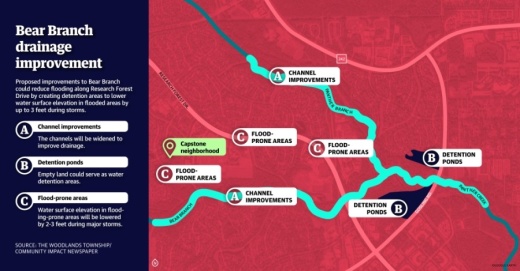Projects seeking state funding include a $9 million Bear Branch drainage improvement plan that could help reduce Research Forest Drive flooding during storms as well as a long-range feasibility study for a reservoir on Spring Creek that could take $400 million and at least 15 years to complete. Also moving forward are projects to help reduce flooding in the Grogan’s Point area and an agreement to launch a science-based advisory committee to study and make recommendations on subsidence in the area.
Waiting for response
Jim Stinson, the general manager for The Woodlands Water Agency, which oversees 10 municipal utility districts in The Woodlands, said a preliminary application is before the TWDB for the first round of approvals, which could lead to grants or grant loans for a Bear Branch channel improvement project.
Overflow from Bear Branch during major storms made Research Forest Drive impassable in major storm events in 2015-17, Stinson said. The Woodlands High School and the Capstone and Twinberry neighborhoods are among the areas that would benefit from the projects, he said.
The $9 million project could lower Bear Branch’s water surface elevation by 2-3 feet during major storms, and channel widening would improve the flow of the water so it would not cross Research Forest, Stinson said. The project would take about six to 12 months to complete, he said.
Another project seeking TWDB approval is the siting study for a reservoir along Spring Creek.The Woodlands Township and several municipal utility districts contributed to a $100,000 preliminary feasibility study on the project.
Bruce Rieser, a member of the township board of directors who also serves on the township’s Drainage Task Force, said three unspecified northwestern county locations were identified that look promising.
“They have identified a possibility of three separate dams on feeder streams to Spring Creek out to the northwest,” Rieser said.
The total cost for three dams would likely be more than $400 million, and it would take about 18 months for a full-scale study, he said. However, it would take at least 15 years to complete the project, he said, including construction, land acquisition and environmental studies.
“There is no such thing as a quick fix to drainage,” Rieser said.Stinson said the improvements identified in the study can be incorporated into a bigger report called the San Jacinto Regional Watershed Master Drainage Plan, which began work in spring 2019.
Information from an Aug. 13 meeting will be available at www.sanjacstudy.org.
Grogan’s Point
The Grogan’s Point area could also see some relief from future flooding with the donation of seven properties off Red Sable Road across from Pastoral Pond and Grogan’s Point parks. The parcels were donated by The Woodlands Development Co., Stinson said.
The Woodlands Development Co. declined to comment on the donations, including the exact acreage and value of the land, but each parcel is suitable for a single-family dwelling, according to a map of the area.
Rieser said although extensive studies have not yet been done on the area, the donations mean the parcels will not be developed.
“I would say at this point that at the very least we’re not going to put down any more hard surfaces that could exacerbate the current situation,” Rieser said. “We have to do some homework to identify whether we can do anything.”Subsidence study
In addition to projects on the ground, a study on another water-related topic is gathering force. The Woodlands Water Agency and the Houston Advanced Research Center have joined with the township to create a scientific advisory committee that could analyze data and studies about the complex issues of groundwater and subsidence.
The Woodlands Township board of directors approved an interlocal agreement July 22 to provide about $45,000 for a groundwater research consortium and science advisory committee, estimated to cost more than $100,000.
“The topic of groundwater and groundwater withdrawal has been a controversial topic for a number of years,” Stinson said at the meeting. “Having the expertise of HARC and their staff to provide an independent third-party review and put that data in a format we and the public can understand looking at groundwater is very important.”
Excessive groundwater withdrawals are thought to contribute to subsidence, or sinkage, he said. Subsidence is also linked to seismic activity and can cause structural damage, he said.





